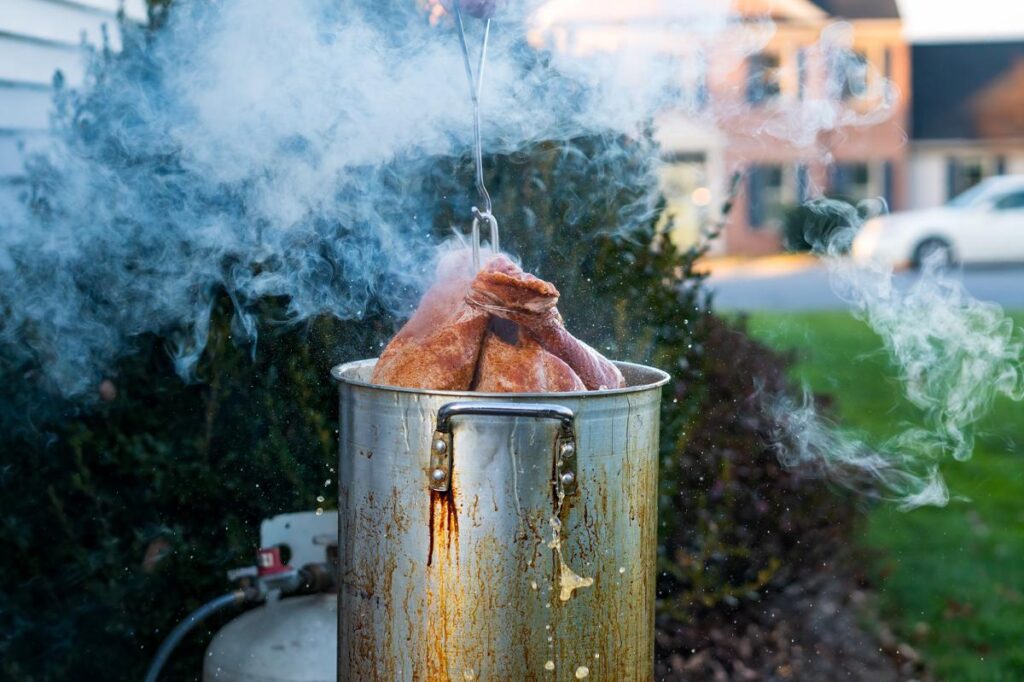Beware of fowl play.
Thanksgiving is supposed to be a day of celebration — but it’s actually one of the most dangerous holidays on the calendar. It’s all too easy to go from breaking bread to breaking bones.
No one knows this better than me. I’ve worked in the ER on Thanksgiving for the last 12 years.
Here are the five most common Thanksgiving injuries and illnesses — and simple ways to avoid a trip to the emergency department.
Cuts and lacerations
We see a lot of lacerations, particularly on the hands and fingers.
People cut themselves all the time on Thanksgiving because they’re using new tools, like shredders, mandolines and especially sharp knives.
Plus, cooks are often distracted because they’re busy talking with family and friends. Maybe they’ve had a few glasses of alcohol.
So I recommend staying focused on the task at hand, carefully reading the instructions of new cooking devices and practicing with them before the big day.
Burns
We also see quite a few patients with burns on Thanksgiving. Burns are often found on the face, hands, forearms and even feet due to dropped food and sauces.
The infamous turkey fryer is a common cause of Thanksgiving burns. They get really, really hot and can overflow if they’re not used correctly.
Not only can turkey fryers injure you — they can spark fires that damage your property.
It’s really important to review the instructions carefully, follow them precisely and wear appropriate protective gear.
I recommend tough cooking mitts that cover your hands, wrists and forearms.
Orthopedic injuries
The next category is trauma to bones, joints, muscles, tendons and ligaments.
Forget football on TV — the real action is the games in the backyard or the horseplay in the living room.
Unfortunately, family fun can lead to major pain. There are a few ways to prevent holiday sprains, fractures and concussions.
First, you should stretch before the family football game. Don’t warm up with a bottle of wine!
Second, remember who your opponents are. Be mindful that your relatives have different physical capabilities and tolerances for stress, so be gentle with them during holiday get-togethers.
Head injuries
Head trauma from falls is also common around the holidays.
It’s important to consider your environment for family members who are at greater risk of falls.
What will the weather be like on Thanksgiving? If it’s going to be icy, do your relatives need help getting inside? Is the walkway well-lit?
Once inside, is there a rug they can trip over? Slippery floors? Toys on the ground?
For kids, ensure that sharp objects and potential poisons are locked away and out of reach and that there’s no access to steep staircases.
Stomach woes
Another frequent cause of ER visits on Thanksgiving is gastrointestinal illnesses.
Before the meal, ask family members and guests if they have any food allergies or sensitivities.
And while overeating and indulging in rich meals can be problematic for anyone, people with heart disease or diabetes face a greater risk of stomach issues because too much salt or sugar can exacerbate their conditions.
Also, be sure to properly handle and store ingredients to avoid food poisoning.
Wash your hands frequently and refrain from sharing utensils with family members. Refrigerate leftovers and toss them after too long.
Unfortunately, choking can also happen during holiday meals. You need to thoroughly chew your food to prevent choking. Slow down as you eat and don’t speak while chewing.
And keep in mind that colds, flus and other respiratory illnesses surge in colder months. Try to avoid contact with ill family members, and stay home if you’re sick.
A flu shot lessens the severity of the illness if you do get infected.
Supplies to stock up on
It’s important to have first aid supplies and basic medications on hand for any family holiday gathering.
Band-Aids, gauze, antibiotic ointment and indigestion medicine should be easily accessible.
Preparation is key to preventing a Thanksgiving trip to the ER. It’s better to spend time with your family and friends, focusing on thankfulness and cheer, than seeing me on your holiday.
Reed Caldwell, MD, is the chief of service for the Ronald O. Perelman Center for Emergency Services at NYU Langone’s Tisch Hospital. He has developed and implemented initiatives to improve sepsis care, geriatric trauma care, stroke processes and patient care space design, as well as the diabetes screening initiative that is standard practice in all NYU Langone emergency departments, which aids in diagnosing thousands of patients with diabetes and prediabetes and connecting them to outpatient care.
Read the full article here

